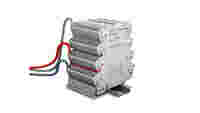Maximum Security at Maximum Speed: EPSITRON® Single-Channel Electronic Circuit Breakers

WAGO's new EPSITRON® Series of single-channel ECBs reliably protect your systems against over-current and short-circuiting. The secondary-side fusing will trigger even in the event of a low over-current that falls within the EN 60204 conditions, thus making it possible to use a cost-effective basic network device. Triggering occurs after just 4 ms in the event of a hard short-circuit.
Your benefits:
- 24 VDC / in five versions for nominal current of: 1 A (787-2861/100-0000), 2 A (787-2861/200-0000), 4 A (787-2861/400-0000), 6 A (787-2861/600-0000), 8 A (787-2861/800-0000)
- With devices color coded according to nominal current
- An extremely slimline design
- Switch-on capacity: >50,000 µF
- Wide ambient temperature range: −25 … +70°C (−13 … +158°F)
- Resetting, on/off switching directly on the module or remotely via digital input signal
- Triggered signal output can also be combined as a group signal for up to 30 devices
- Approvals: CE, UL 61010, UL 2367